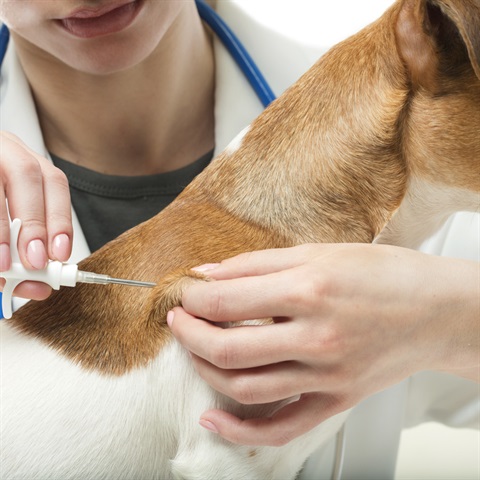Registration and Microchipping

Companion animals have come to play an important part in the lives of many people. Most homes in Australia have at least one companion animal. Pets are a wonderful source of companionship and pleasure for many people. Under the NSW Companion Animals Act 1998, all cat and dog owners must complete a 3-step process to registering their pet.
STEP 1 | Microchipping
A companion animal must be identified by a microchip as required by the regulations from the time the animal is 12 weeks old and must not be sold unless it is microchipped, even if it is younger than 12 weeks. Microchipping ensures that all companion animals have a means of permanent identification that cannot be lost or tampered with. Microchipping means that owned and unowned animals are readily identifiable so that they can be promptly returned to their owners or re-homed.
Microchips are tiny - about the size of a grain of rice - and can be inserted under the skin between the shoulders of a cat or dog. The process is similar to receiving immunisation injections and is generally less distressing for the animal than a vaccination.
Once you have microchipped your animal, the details will be sent to your local council for data entry into the NSW Companion Animals Register. You will also be posted a Certificate of Identification.
Councils, pounds, vets and animal welfare organisations will be able to read the microchip by passing a scanner over the animal. Thanks to the microchip, if your animal is found, lost or roaming a Council Ranger can contact you to arrange for your animal’s return and if it is taken to a pound, the pound will scan the animal and promptly contact you.
It is therefore extremely important that your contact details are kept up to date.
STEP 2 | Lifetime Registration
Once your animal is microchipped, the next step is lifetime registration. All pet cats and dogs in NSW must be registered on the NSW Pet Registry either by 12 weeks of age or immediately upon transfer (whichever happens first). The registration fee is a once-only payment covering the pet cat or dog for its lifetime in NSW, regardless of changes in ownership.
Lifetime registration incurs a once only fee that can be paid online through the NSW Pet Registry or at any local council. The animal owner must be 18 years old or over.
Once owners have paid lifetime registration, a Certificate of Registration will be emailed to registered to the pet owner. In the event there is no email address, the Certificate will be posted.
For registration forms and information about the NSW Companion Animals Act 1998, breeders, pet shops, vets and microchip identifiers, visit the NSW Office of Local Government website.
Pet owners can pay for lifetime registration using the NSW Pet Registry website or through their local Council.
How to register your Animal
You are able to apply for lifetime registration in any of the following ways:
- Online through the NSW Pet Registry:
- Logon to the NSW Pet Registry website, find your pet using the microchip number and pay by credit card.
- If you have difficulty with completing registration through the website please contact telephone: 1300 134 460 between 9.00am and 4.30pm, Monday to Friday or email: pets@olg.nsw.gov.au for assistance.
- By Email: Send the Lifetime Registration form or annual permit form along with payment by completing the credit card authorisation form to cityofryde@ryde.nsw.gov.au. You can download a copy of these forms or call Council on 9952 8222 to post you out a copy.
- In Person: At City of Ryde Customer Service Centre located at 1 Pope Street, Ryde. See opening hours.
- By Post: Send the Lifetime Registration form with payment in by cheque, money order or completed credit card authorisation form to:
Chief Executive Officer
City of Ryde
Locked Bag 2069
NORTH RYDE NSW 1670
For information on registration exemption, see the Companion Animals Regulation 2018.
Registration Fees
To see a list of registration categories and current fees, visit OLG’s Registration and permit fees page.
Please note that if your pet was obtained from a registered pound/shelter/rehoming organisation, or you are an eligible pensioner, you will need to pay the registration fees (if applied) through your local council.
STEP 3 | Desexing/Sterilising Your Pet
Pet owners should always speak to a vet for specific advice on desexing.
Alternatively, please submit the certificate to Council for processing. This allows you to delay or avoid extra fees or annual permits for non-desexed pets.
Once your pet has been desexed, their registration details will need to be updated (this can be done by your Vet or by submitting a desexing/sterilisation certificate to Council).
If you choose to not desex your pet, and they will not become a breeding animal, you must complete a non-desexed cat and dog fees form and submit to Council with the relevant fee.
Owners of non-desexed cats over 4 months of age must pay an annual permit. Owners of non-desexed dogs over 6 months of age must pay a once-only additional fee.
If Vets recommend you delay desexing for medical reasons, or avoid it entirely, they can also record this on the NSW Pet Registry. They may, alternatively, give you a certificate declaring a temporary or permanent desexing exemption. They must do this prior to your pet reaching the recommended desexing age (6 months for dogs, 4 months for cats).
Alternatively, please submit the certificate to Council for processing. This allows you to delay or avoid extra fees or annual permits for non-desexed pets. . If your vet has provided you with a temporary exemption, you must have your pet desexed by the date stated by the vet to avoid additional fees or annual permits.
Moving House
Don't forget to change the registration details of your pet if you move house.